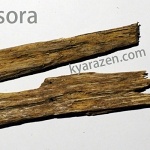Several incense houses in Japan have been known to create blended incense sticks based on their impression of the Ranjatai through Mon-koh. Small fragments of the Ranjatai are known to be in possession of descendants of kodo masters and big incense companies, from which they draw inspiration into crafting a representative incense based on the… [Read More…]
Two controversial identities of Golden Silk Kynam
金丝奇楠, or Golden silk kynam in modern day suffers two controversial identities. Under modern grading of authentic kynam, high end dealers in Hongkong occasionally classify some kynams as golden silk kynam due to the golden silky streaks of resin present in the wood, with the other grades being silver silk, coffee kynam, or simply normal… [Read More…]
Usage of Kynam or Kyara in the naming of modern Incense products
In the recent years, there are many incense products on the market that are marketed as “kynam incense” or “kyara incense”, of which many consumers are easily convinced to make a purchase without reading the fine prints. It seems that the Japanese incense companies are the only ones making incense with kyara/kynam, with some sticks… [Read More…]
Perspectives on the Rikkoku Gomi
The Rikkoku Gomi set was first assembled around the 15th Century with the establishment of a formalized “way/art” of the Incense by founder Sanjonishi Sanetaka (1455-1537 AD), a noble under the Muromachi Shogunate of Shogun Ashikaga Yoshimasa. Without the benefits of modern logistics, and being more isolated from the rest of the world, agarwood import… [Read More…]
Is there any difference between Kyara and Kinam?
Traditionally, the word 玉 or Jade refers to two types of beautiful stone materials, either the Chinese historical Nephrite (calcium magnesium sillicates), known for its creamy, smooth and elegant texture, or the Burmese Jadeite (sodium aluminum silicates), reknown for its lovely green hues and icy translucencies. However today, the word玉/Jade is now applied to… [Read More…]
Experience Green-oil Kyara!
*Edit – Out of Stock!! Ever wondered how that elusive USD $500/gram green oil kyara smells like? One could spend years reading about kyara, thousands of words describing what it smells like, what its properties are like.. but all it takes is just a single encounter in person to truly know what kyara is. This… [Read More…]
What is Kyara or Kynam?
Kyara/Kynam/Kinam is a tiny subset within aloeswoods in a very very small percentage. In a historical context, it refers to a special type/grade of aloeswood with unique and excellent fragrance properties. The Chinese have a saying that one needs an accumulation of 3 lifetimes of virtues before one would have the chance of encountering real… [Read More…]
History of Kyara
Kynam, qinan (奇楠), kyara. The esteemed names of a very precious fragrant material on earth that almost no one seem to truly know in the modern world today. Historically, the Vietnamese called it calambac, in Sanskrit, it was recorded as kala-nam. The chinese words for kynam can be found with two variations of the word qi (奇), of which the former refers to unique, amazing, special. Nan (楠) refers to a certain wood type with three categorical species, where xiang nan or fragrant nan is one of them.







